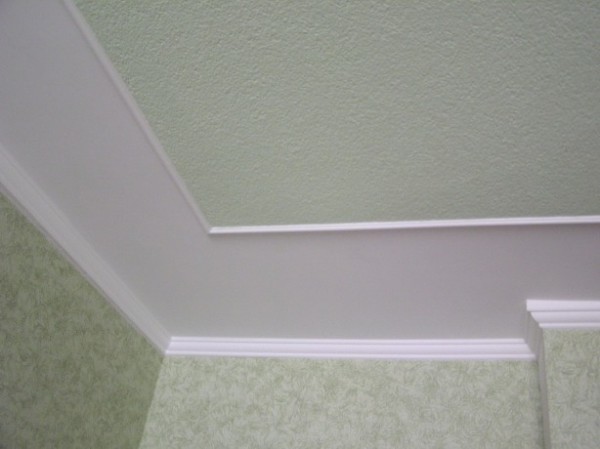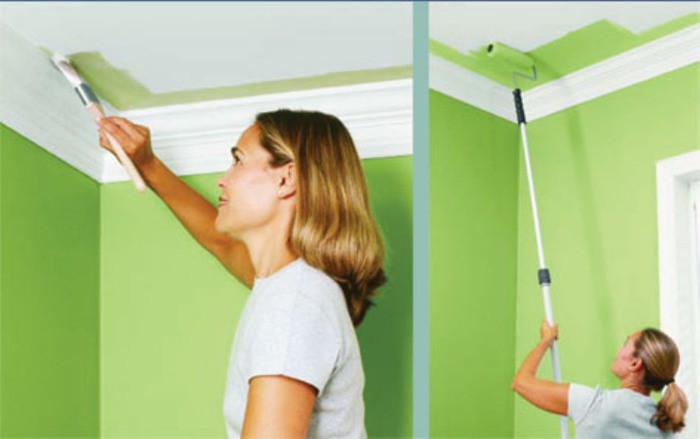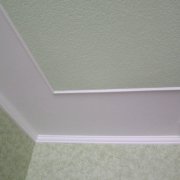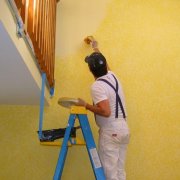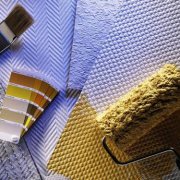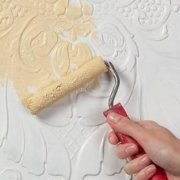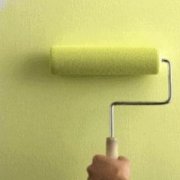How is painting the wallpaper on the ceiling
How to paint the wallpaper on the ceiling and how to do it right, we will understand today. Indeed, in some cases, this will be the best solution. Only here is there its own specificity, because the wallpaper should not peel and swell. In the video in this article, you can see everything clearly and this will help to do the job correctly.
The content of the article
Drawing paint on wallpaper
All of the work can be done with your own hands, then its price will not be significant. Below is an instruction on the rules of work.
Before you start painting the wallpaper, you must first check how the wallpaper adheres to the ceiling.
Caution: You will have to make sure that there are no swellings. If defects are found, be sure to eliminate them. Otherwise, at the end of the work, the painted areas swell even more. This will cause the wallpaper to peel off in the future. No mistakes should be made, because even one trifle will spoil the entire appearance of the ceiling.
- Before painting, you need to think about how to protect the floor, walls from paint. To avoid such problems, you can use polyethylene coatings or plain paper. For their fastening, a magnetized special masking tape is ideal. All this will save you from the extra hassle associated with removing traces of paint.
- If you have to paint polyurethane foam, gypsum moldings that are adjacent to the ceiling, then adhesive tape is best glued to the edge of the baguettes. Upon completion, it is easily removed.
Tool preparation
Before painting the ceiling, it is necessary to prepare working equipment.
You will have to use:
- The material that will protect the surface, i.e. paper or polyethylene;
- Rollers (see Paint rollers: consider in detail), in which the coat is 10 or 12 mm;
- Brushes up to 8 cm wide and 1.5 cm thick;
- Paint;
- Capacity in which paint will be rolled;
- Headgear, safety glasses, gloves.
All this must be prepared before painting the ceiling. During the workflow, you won’t have to be distracted.
- The roller is best selected depending on the type of wallpaper used. Suitable models with a long pile. It must be remembered that the smoother the surface of the canvas, the less pile is used. This factor affects the quality of the paint.
- When buying paint, you must definitely study the instructions. Everything that the manufacturer recommends must be considered. For example, humidity and room temperature are of great importance. They should be as indicated by the manufacturer. After painting, there should be no drafts in the room.
Attention! Buy only that paint that is suitable for specific types of wallpaper. Alkyd or water-based paints are suitable for cullet. Non-woven wallpaper is painted with water-dispersive enamels.
These types of paints have both advantages and disadvantages:
| Acrylic | Alkyd options allow you to create an impermeable solid film.
|
| Water dispersible | These dyes are environmentally friendly. Their durability depends on what polymer additives, acrylic.
|
Attention: The instruction from the manufacturer states that you need to dilute the paint with water. Enamel is filtered through cheesecloth. Then water is added and everything is mixed with a mixer.
Ceiling Painting: Milestones
Now how to paint the wallpaper on the ceiling with water-based paint and any other. From kind of wallpaper choose a method of painting. If a fiberglass cloth was used, then first paint the corners, perimeters along the edges with a brush. Further it is already possible to work with a roller over the entire surface of the ceiling.
- There are situations when the perimeter of the surface is large. So there is a risk of drying the paint. Then you need to break the work into several stages: first paint one area of the surface. Then they move on.
- It is best to carry out voluminous work together. For example, one works along the edges, and the other person paints the rest of the surface with a roller.
With non-woven wallpaper, there are some nuances of staining:
- Painting is carried out as with cullet;
- Wallpaper can be painted before sticking. For this, latex water-dispersion paint is used. Outside, non-woven stain. They do not touch the base, and after drying, you can proceed to pasting the ceiling;
- Another way of working is to paint the ceiling in a bright shade first. When the surface dries, you can stick the wallpaper. Since non-woven paper is translucent, so the result is an interesting ceiling;
- Painters use another painting option. Dispersion paint is diluted stronger. Then, with its help, the ceiling is painted. The structure of the wallpaper is slightly wiped with a rag. The basis of the wallpaper will be darker, and the picture will be more tender. Experienced painters still highlight the picture with contrasting paint.
Tips from professionals:
- It is better to soak the roller coat before work. This will prevent the hair from falling out during painting. A warm soapy solution is used for soaking. A roller is left in it for 10 minutes. Then you need to rub it well, for example, hand in hand. All excess villi will fall out.
- The roller does not need to be completely immersed in the cuvette. It is enough to lower one side by a few centimeters, then the other. The roller is evenly rolled out so that the paint is well distributed.
- Paint is best applied in several layers. First, the ceiling is painted over vertically, that is, the movements look like the letter W. When the first layer dries, then the next layer is applied horizontally. So you can get a uniform surface color.
- Since wallpaper dries too quickly during painting, it is better to increase the humidity level in the room. A simple humidifier can be used for this. A basin of hot water will also help to achieve the desired result. You can cover the radiators with wet towels
- If there is a desire to highlight the wallpaper pattern after painting, it is necessary to paint the surface a third time. Only this time the work is done with light movements. A rubber or velor roller is suitable for painting.
How to paint non-woven wallpaper
Non-woven wallpaper allows you to translate into reality interesting ideas. The outer layer is made of foamed polyvinyl, and the inner is made of fleselin.
If the wallpaper has a uniform structure, then they need to be painted only on the front side. But fans of experimentation choose original methods of staining. There are interesting ways to paint.
Here are some of them:
- Latex paint applied to the canvas before wallpapering. Work is carried out only from the wrong side. This will save volumetric drawings, get a soft background and the desired shade.
- If you paint the ceiling before wallpapering, you can get a colored background. This is achieved through a transparent wallpaper base. The ceiling will acquire a gentle pastel shade.
- An expressive pattern on non-woven wallpaper is obtained as follows. The first layer is applied with paint diluted with water. Enamel residues are removed with a rag. When this layer dries, apply the next one - they just take a thick paint with a contrasting shade.
How to paint old paper and non-woven wallpaper
This work has its own specifics. After all, non-woven fabric, like paper, can swell and peel off when wet.
- First you need to check the surface. Wallpaper should hold tight to the ceiling. Peeling, swelling is not allowed. Check joints thoroughly. On old wallpaper, they can peel off. So this defect will have to be fixed. It is enough to draw glue into the syringe and drive it into the resulting voids. The wallpaper is then pressed firmly to the ceiling.
- It is imperative that dust be removed from the surface of the ceiling before work, because a sufficient amount has accumulated on old wallpaper. Removing the dust layer is the first work before painting. It is better to use a soft rag, previously moistened a little.
- The ceiling is cleaned, dried, which means you can apply a coat of paint. It should be a little, so as not to glue the glue, otherwise you will have to do complex and financially expensive work.
- The first layer of the applied paint has dried, then you can proceed to the next step. Wallpaper is covered with a final layer of paint.
The technology for painting wallpaper canvases is not a complicated process. The result is an exclusive ceiling.
- During painting, it is possible to hide the existing defects. In addition, the surface is durable, moisture resistant.
- Painted wallpaper will not fade, a relief pattern can look beautiful. Painting - cost-effective repair work that is available to almost everyone.
- Today in construction stores you can find a wide variety of colors, wallpapers that will help transform the room. Moreover, their price is not high. Paints are better to use water-based, without harmful components.
Painting the wallpaper on the ceiling is not difficult, you just need to choose the right colorings. If you follow the recommendations listed above, the result will be perfect. Almost types of wallpaper are suitable for painting. It can be paper or fiberglass cloth.
The right materials will help transform the ceiling in a modern style. So look at the photo and you can purchase materials.
